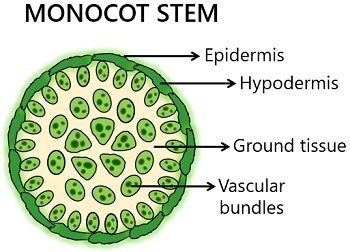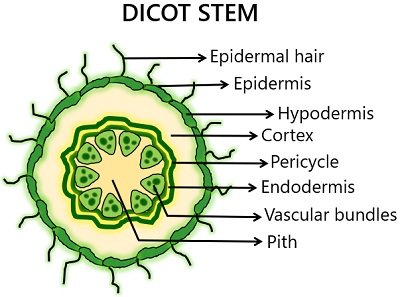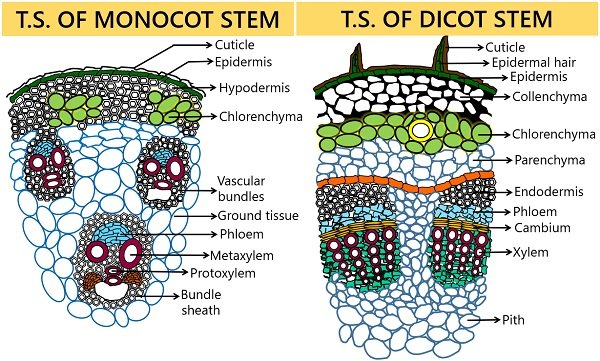The difference between monocot and dicot stem is mainly in the arrangement and type of the vascular system. Vascular structures in the stem facilitate the upward and downward flow of water and nutrients from the root to the leaves and vice versa.
The vascular bundles in the monocot stem are dispersed, whereas the monocot stem possesses vascular bundles in the ring pattern. The stem of monocots contains a closed-type of vascular system due to the absence of cambium. Oppositely, the stem of dicots comprises the open-type vascular system that includes cambium in between phloem and metaxylem.
This post describes the key differences between the monocot and dicot stem, along with the comparison chart. You will also get to know the definition, diagrams and anatomical differences between the two.
Content: Monocot Vs Dicot Stem
Comparison Chart
| Properties | Monocot Stem | Dicot Stem |
|---|---|---|
| Meaning | The monocot stem is composed of ground tissues with two distinct regions, namely hypodermis and parenchymatous zone | The dicot stem is composed of ground tissues with distinct intrastelar and extrastelar layers |
| Trichomes (Epidermal hairs) | Absent | Present |
Cortex (Extrastelar ground tissue) |
||
| Differentiation of cortex | Undifferentiated cortex is present | Cortex is well differentiated into hypodermis, parenchymatous zone and endodermis |
| Hypodermis | Contains sclerenchyma cells | Contains collenchyma cells |
| Parenchymatous zone | Possesses loosely arranged thin walled parenchymatous cells with intercellular spaces | Possesses tightly arranged parenchymatous cells with no intercellular spaces |
| Endodermis (Starch sheath) | Absent | Present |
Stele (Central cylinder) |
||
| Arrangement of vascular bundles | Vascular bundles are numerous and irregularly dispersed in the parenchymatous zone, i.e. they are atactostele | A few vascular bundles are arranged in the ring pattern |
Vascular bundles |
||
| Number | Numerous | Four to eight vascular bundles |
| Size | Vascular bundles toward the centre are comparatively larger than those are present towards the periphery | Vascular bundles are equal in size |
| Shape | Oval-shaped | Wedge-shaped |
| Type | Closed | Open |
| Cambium | Absent | Present |
| Secondary growth | Absent | Present |
| Bundle cap | Absent | Present |
| Bundle sheath | Absent | Present |
| Water cavity | Absent | Present |
| Phloem parenchyma | Present | Absent |
Intrastelar ground tissue |
||
| Pericycle | Absent | Present outer to the vascular bundle |
| Pith | Absent | Dicot stem contains pith made of parenchyma cells |
| Medullary rays | Absent | Present between the vascular bundle |
Definition of Monocot Stem
Monocotyledons are flowering plants having a stem with a simple vascular system. The epidermis of monocot stems has a compact arrangement of tubular cells, with cuticularised outer walls.
They have no cortex due to the absence of extrastelar and interstelar regions. The monocot stem is wholly composed of the ground tissue with hypodermis and a parenchymatous zone.
Numerous vascular bundles lie within the parenchymatous ground tissue with no particular arrangement.

Definition of Dicot Stem
Dicotyledons are flowering plants having a stem with a complex vascular system. The epidermis of dicot stems comprises closely packed tubular parenchyma cells with cuticularised outer walls.
A few multicellular hairs or trichomes can be seen over the outermost layer. The extrastelar ground tissue, i.e. cortex, is present beneath the epidermis, and it is differentiated into distinct hypodermis, parenchymatous zone and endodermis regions.
The central cylinder, i.e. stele, contains vascular bundles in the form of a ring. Pericycle, pith and medullary rays contribute to the formation of intrastelar ground tissues.

Anatomical Differences
Let us look into the transverse section of the monocot and dicot stem to understand the anatomical differences.

Epidermis
In both monocot and dicot stems, the epidermis is the outermost single-layered tissue that contains parenchyma cells without intercellular spaces.
The stems of monocotyledons and dicotyledons have cuticularised outer walls. Besides that, there is a characteristic difference in the epidermis layer of the monocot and dicot stem.
Dicot stems possess multicellular hairy structures or trichomes over the outermost layer, whereas the monocot stem lacks trichomes.
Epidermis, along with the cuticle, safeguards the internal cells against any injury (due to physical, chemical and mechanical sources), desiccation and infection.
Cortex
It is the intermediating layer between the epidermis and stele. The stem of monocotyledonous plants contains a non-differentiated cortex, or they wholly comprise ground tissues with hypodermis and parenchymatous zone.
Conversely, the stem of dicotyledonous plants has a well-differentiated cortex subdivided into endodermis, pericycle, and pith.
- Hypodermis: It is the layer present beneath the epidermis. The hypodermis contains (sclerified parenchyma) beneath the epidermis, while dicot stems possess multilayered collenchyma cells giving mechanical support to the plant.
- Parenchymatous zone: It is present beneath the hypodermis, extending up to the stem’s centre. The parenchymatous zone of monocot stems has roughly packed thin-walled parenchymatous cells with abundant intercellular spaces. Numerous vascular bundles lie within the parenchymatous ground tissue. Dicot stems have many layers of closely packed parenchyma cells with no intercellular spaces.
- Endodermis: It can be distinctly seen in the dicot stem but absent in monocots. It is also known as the starch sheath due to the abundant starch granules. It appears single-layered and consists of barrel-shaped cells.
Vascular Bundles
They contain conducting tissues such as the xylem and phloem, which transport water and food to various plant’s parts. Its presence is one of the important properties through which we can easily differentiate between the monocot and dicot stem.
- Arrangement: Monocot stem contains vascular bundles dispersed in the ground tissue. Dicot stem comprises vascular bundles around a cambium ring.
- Size: The stem of monocots possesses small-sized vascular bundles near the periphery and large-sized vascular bundles at the centre. Oppositely, the stem of dicots contains the same-sized vascular bundles.
- Number: The stem of monocots contains numerous vascular bundles, whereas the stem of dicots contains 6-8 vascular bundles.
- Shape: Monocot stems have oval-shaped vascular bundles, whereas dicot stems have wedge-shaped vascular bundles.
- Type: Monocot stems have conjoint, collateral, endarch and closed vascular systems, while dicot stems have conjoint, collateral, endarch and open vascular system.
- Secondary growth: It occurs in dicot stems, whereas the monocot stems do not exhibit secondary growth.
- Bundle caps: It is present in dicot stems, while absent in monocot stems.
- Bundle sheath: It is present in the stem of monocots, whereas absent in the stem of dicots.
- Water cavity: It is present in the monocot stem, whereas absent in the dicot stem.
- Phloem parenchyma: Dicot stems possess phloem parenchyma, while monocot stems do not.
Intrastelar Ground Tissue
It is a region found within the central cylinder or stele. Intrastelar ground tissues only exist in the dicot stem with three distinct layers (pericycle, pith and medullary rays).
- The pericycle either possesses sclerenchyma cells or patches of sclerenchymatous or parenchymatous cells. It encircles the vascular tissues and is termed the bundle cap and hard bast.
- The pith or medulla possesses spongy parenchyma cells.
- Parenchymal strips or medullary rays are present between the vascular bundle.
Key Differences Between Monocot and Dicot Stem
- Monocot stem possesses cells differentiated into the epidermis layer and ground tissues with two distinct regions (hypodermis and parenchymatous zone). Oppositely, the dicot stem contains cells differentiated into the epidermis layer, extrastelar ground tissues, stele and intrastelar layers.
- Trichomes or epidermal hairs are the epidermal outgrowths resulting from the cellular divisions in the single-layered epidermis zone. They perform a primary role in carbon assimilation, mechanical and chemical defence. Dicotyledons may bear trichomes over the epidermis layer of the stem, while the monocot stem lacks such structures.
- Cortex or extrastelar ground tissue is the region lying between the surface cells and conducting tissues. Monocot stems do not carry a well-differentiated cortex. Conversely, dicot stems have a well-differentiated cortex with three distinct regions (hypodermis, parenchymatous zone and endodermis).
- Stele or central cylinder is the middle portion containing vascular bundles. Monocot stems have numerous vascular bundles with no particular arrangement. Oppositely, stele in dicot stems can be seen clearly in the form of a circular array of nearly 6-8 vascular bundles.
- Intrastelar ground tissues are present within the stele, which include pericycle, pith, and medullary rays. The dicot stem carries intrastelar ground tissues, while the monocot stem does not.
Similarities
- The presence of a single-layered epidermis is a common feature in both monocot and dicot stems.
- Cuticularised outer walls are present in both groups.
- A significant portion of the ground tissue is parenchymatous in monocot as well as dicot stems.
- Chlorenchyma tissues are present in both groups.
- Xylem and phloem contribute to the vascular system and contain proto-elements (like protoxylem and protophloem) and meta-elements (like metaxylem and metaphloem) in both groups.
- Vascular bundles are conjoint and collateral in monocot and dicot stems.
Conclusion
Therefore, we can conclude that the monocot and dicot stem differ in the ground tissues differentiation, epidermal outgrowths and size, shape and arrangement of vascular bundles.